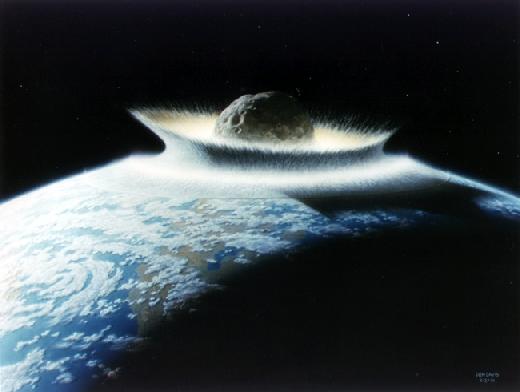 |
| Artists impression of an asteroid impacting the Earth. Photo: Don Davis/NASA |
Meteorites:
Every day hundreds of thousands of meteors crash into the Earth. The vast majority are just a few millimetres in size. As they enter the atmosphere, they ionise the air around them, causing it to glow. We see them mainly at night when it is dark. The fragments are so small that they burn up at a height of about 100km. Often however, large fragments penetrate deeper into the atmosphere and reach terminal speed, resulting in them reaching the surface in tact. We call these meteorites. A very small, but real, possibility exists of someone losing their life over a meteorite impact.
The Earth, and all the planets, were formed from the accretion of planetesimals (giant chunks of rock and metal). Today, the asteroids are all that remain of the planetesimals. Most of the asteroids lie between the orbits of Jupiter and Mars, but a few are found closer. Some of these, intersect the Earth's orbit and are known as Earth crossing asteroids. Their orbits are not entirely stable and can be disrupted by close passes of the planet Jupiter. It is entirely possible in the future, that the orbit of a relatively large Earth crossing asteroid, can be disrupted sufficiently by Jupiter's enormous gravity field, to send it on a collision course with Earth. A collision with such a large body can produce enough environmental damage to threaten all life on the Earth. Indeed, it is believed that a collision with an asteroid caused the extinction of the dinosaurs 65 million years ago. Another such collision in the near future, will be calamitous for mankind and end civilisation as we know it.
Closeup view of the surface of the Earth Crossing asteroid, EROS.
NEAR Spacecraft flyover movies of the Earth Crossing asteroid, EROS.
NEAR Spacecraft flyby of the asteroid Mathilde (encountered on its way to EROS).
In addition to asteroids, collisions by comets are just as likely. Comets are thought to originate in a region of space just outside our Solar System called the Oort Cloud. Comets are erratic and unpredictable. If a comet were on a collision course with the Earth, we would have little warning of it and insufficient time to take preventative action. In 1994, the comet Shoemaker-Levy 9 collided with the planet Jupiter. The impact effects spread over an area more than four times that of the Earth, and validated various theoretical impact models.
It is estimated that a catastrophic impact will occur about once every 100,000 years. An average Australian has a greater probability of dying as a result of such an asteroid or comet impact than from a plane accident.
Asteroids:
Movie #1
Movie #2
Movie #3
Comets:
Damage Estimates:
Damage Estimates from Impacts of Various Sized Bodies
| Size | Damage | Detailed Damage Description |
| 1 cm | No Damage | Typical bright "shooting star". Most "burn up" at over 70km altitude. | 1 m | Minor Damage | The lighter "cometary type" material will disintegrate at high altitude (70+km) producing a bright fireball only, but the stony or iron bodies will be likely to produce a small (or several small) meteorites. Fractures in the body will cause the body to fragment and and give a "firework" appearance to the fireball. Several of these might eventually become meteorites. The deceleration is dramatic and the body slows to under about 5km/sec (from typically 20-30km/sec for meteorites) by the time it reaches 20km. At this speed the body slows below the point where friction with the air makes it glow. Impacts by the meteorites give only small "craters" in the ground typically less than 1m across, but can smash through roofs or badly damage car bodywork. | 100 m | Getting Pretty Serious | Getting pretty serious here. The atmosphere has little effect until the body gets down to around 5km. The dramatic density increase can fracture a body and this dumps huge amounts of energy into the atmosphere. The fireball itself is intense; much brighter than the Sun, and will cause local fires just from the radiant energy of the fireball. Local devastation on impact. Some climatic disturbance, and only very localised species could become extinct. Economic disturbance larger than any known natural disaster in modern history. | 1 km | Civilisation Threatening | This is getting into the civilization threatening size. Spontaneous fires in all localities within direct line of sight. The crater will be city sized and the ground tremors and debris from the crater will devastate a state wide area. Most coastlines of the word will experience some sort of tsunami, but massive if the impact is in the ocean. Lingering global consequences, massive initial deaths, collapse of agriculture for at least one growing season in both hemispheres and societal collapse. This is the current mininum size being targeted by the proposed NASA search strategy, but others feel a smaller limit should be chosen to give more leeway in the theory and practicalities. | 10 km | Species Extinction Event | . | 100 km | Human Extinction | Mankind unlikely to survive. Major species extinction with few if any higher life forms surviving. |